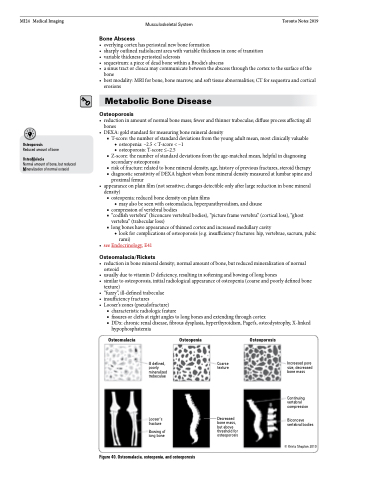Page 692 - TNFlipTest
P. 692
MI24 Medical Imaging
Musculoskeletal System
Toronto Notes 2019
Osteoporosis
Reduced amount of bone
OsteoMalacia
Normal amount of bone, but reduced Mineralization of normal osteoid
Bone Abscess
• overlyingcortexhasperiostealnewboneformation
• sharplyoutlinedradiolucentareawithvariablethicknessinzoneoftransition
• variablethicknessperiostealsclerosis
• sequestrum:apieceofdeadbonewithinaBrodie’sabscess
• asinustractorcloacamaycommunicatebetweentheabscessthroughthecortextothesurfaceofthe
bone
• bestmodality:MRIforbone,bonemarrow,andsofttissueabnormalities;CTforsequestraandcortical
erosions
Metabolic Bone Disease
Osteoporosis
• reductioninamountofnormalbonemass;fewerandthinnertrabeculae;diffuseprocessaffectingall bones
• DEXA:goldstandardformeasuringbonemineraldensity
■ T-score: the number of standard deviations from the young adult mean, most clinically valuable
◆ osteopenia: –2.5 < T-score < –1
◆ osteoporosis: T-score ≤–2.5
■ Z-score: the number of standard deviations from the age-matched mean, helpful in diagnosing
secondary osteoporosis
■ risk of fracture: related to bone mineral density, age, history of previous fractures, steroid therapy
■ diagnostic sensitivity of DEXA highest when bone mineral density measured at lumbar spine and
proximal femur
• appearanceonplainfilm(notsensitive;changesdetectibleonlyafterlargereductioninbonemineral
density)
■ osteopenia: reduced bone density on plain films
◆ may also be seen with osteomalacia, hyperparathyroidism, and disuse
■ compression of vertebral bodies
■ “codfish vertebra” (biconcave vertebral bodies), “picture frame vertebra” (cortical loss), “ghost
vertebra” (trabecular loss)
■ long bones have appearance of thinned cortex and increased medullary cavity
◆ look for complications of osteoporosis (e.g. insufficiency fractures: hip, vertebrae, sacrum, pubic rami)
• seeEndocrinology,E41
Osteomalacia/Rickets
• reductioninbonemineraldensity;normalamountofbone,butreducedmineralizationofnormal osteoid
• usuallyduetovitaminDdeficiency,resultinginsofteningandbowingoflongbones
• similartoosteoporosis,initialradiologicalappearanceofosteopenia(coarseandpoorlydefinedbone
texture)
• “fuzzy”,ill-definedtrabeculae
• insufficiencyfractures
• Looser’szones(pseudofracture)
■ characteristic radiologic feature
■ fissures or clefts at right angles to long bones and extending through cortex
■ DDx: chronic renal disease, fibrous dysplasia, hyperthyroidism, Paget’s, osteodystrophy, X-linked
hypophosphatemia
Osteomalacia
Osteopenia
Osteoporosis
Figure 40. Osteomalacia, osteopenia, and osteoporosis
Ill defined, poorly mineralized trebeculae
Looser’s fracture
Bowing of long bone
Coarse texture
Decreased bone mass, but above threshold for osteoporosis
Increased pore size, decreased bone mass
Continuing vertebral compression
Biconcave vertebral bodies
© Krista Shapton 2010


